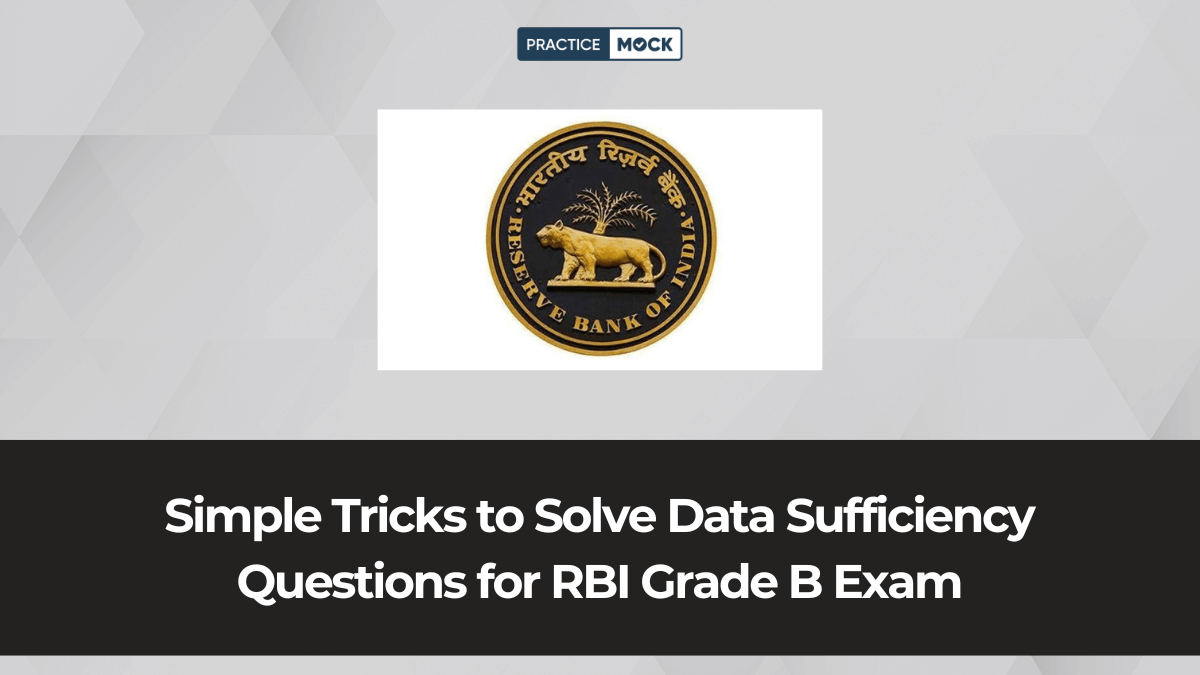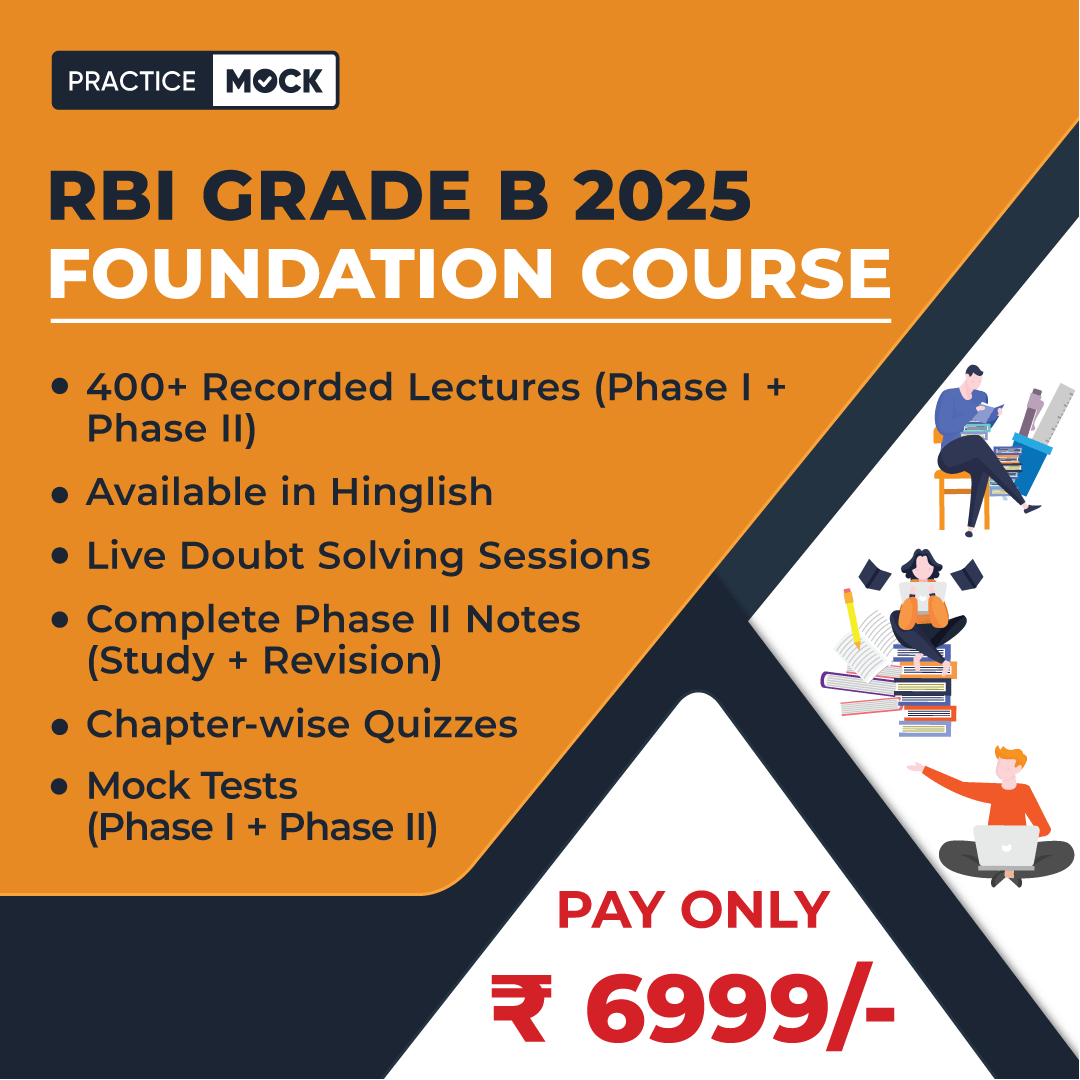In the RBI Grade B Exam, one of the most challenging topics for aspirants can be Data Sufficiency. It keeps popping up in Phase 1 under the head Reasoning Ability section, and sometimes even in Quantitative Aptitude. These questions test candidates’ ability to evaluate given statements and decide whether they provide enough information to answer a question. Many candidates lose marks due to confusion or overthinking. However, with the right approach and practice, Data Sufficiency can become a scoring area and boost your overall confidence in the exam.
Easy Tricks to Solve Data Sufficiency Questions
Many aspirants struggle with Data Sufficiency because they try to solve the actual question rather than evaluating the statements. These simple tips will help you change that approach and solve such questions with more clarity and speed.
Tip 1: Understand the Question Type First
Before checking the statements, know exactly what is being asked.
- Read the main question carefully.
- Identify the subject (age, number, direction, etc.).
- Don’t assume any data beyond what’s given.
- Check if it’s a “Yes/No” or “Value” type question.
- Focus on what needs to be found.
Tip 2: Don’t Try to Solve It Fully
Just check if the data is enough to answer.
- Evaluate statements individually first.
- Don’t combine unless required.
- Don’t calculate exact answers unless needed.
- Look for sufficiency, not solutions.
Tip 3: Use Elimination Method
This helps you quickly find the right option.
- Leave options that are clearly insufficient.
- Spot contradictory or vague statements.
- Eliminate based on logic and structure.
- Save time on tough questions.
- Use smart guesswork when needed.
Tip 4: Memorize Standard Formats
Knowing question types helps in quick identification.
- Practice common question patterns.
- Recognize repeat logic types.
- Note key phrases that change meaning.
- Watch for tricky wording.
- Familiarity speeds up accuracy.
Tip 5: Practice with Timers
Time-based practice builds exam stamina.
- Set a timer for every practice set.
- Track your average solving time.
- Focus on accuracy under pressure.
- Review your mistakes carefully.
- Build speed with regular practice.
Click on the Banner below & Check Out The best Foundation Course for Complete Preparation for Toppers
Data Sufficiency Practice Questions & Answers
You should practice Data Sufficiency questions, as this may help you to attempt these types of questions in a perfect way.
Question 1: The question consists of two statements numbered “I and II” given below it. You have to decide whether the data provided in the statements is sufficient to answer the question.
A, B and C together can complete the work in 36 days. In how many days C alone can complete the work?
Statement I: B and C together can complete the work in 52 days.
Statement II: B is 50% more efficient than A.
A) The data in statement I alone are sufficient to answer the question, while the data in statement II alone are not sufficient to answer the question.
B) The data in statement II alone are sufficient to answer the question, while the data in statement I alone are not sufficient to answer the question.
C) The data either in statement I alone or in statement II alone are sufficient to answer the question.
D) The data given in both statements I and II together are not sufficient to answer the question.
E) The data in both statements I and II together are necessary to answer the question.
Question 2: The question consists of two statements numbered “I and II” given below it. You have to decide whether the data provided in the statements are sufficient to answer the question.
The incomes of ‘A’ and ‘B’ are Rs. 28000 and Rs. 20000, respectively. The expenditure of ‘A’ is how much percent more/less than that of ‘B’?
Statement I: The savings of ‘A’ is 40% more than that of ‘B’.
Statement II: ‘A’ and ‘B’ both spends 25% of their respective incomes.
A) The data in statement I alone are sufficient to answer the question, while the data in statement II alone are not sufficient to answer the question.
B) The data in statement II alone are sufficient to answer the question, while the data in statement I alone are not sufficient to answer the question.
C) The data either in statement I alone or in statement II alone are sufficient to answer the question.
D) The data given in both statements I and II together are not sufficient to answer the question.
E) The data in both statements I and II together are necessary to answer the question.
Question 3: The question consists of two statements numbered “I and II” given below it. You have to decide whether the data provided in the statements are sufficient to answer the question.
There are three persons ‘A’, ‘B’ and ‘C’. ‘A’ can complete 20% of work in 5 days. Find the ratio of efficiencies of ‘A’ to that of ‘C’.
Statement I: ‘B’ takes 10 days less than ‘C’ to complete the work, while ‘A’ and ‘B’ together can complete 72% of the work in 8 days.
Statement II: ‘C’ is least efficient among all.
A) The data in statement I alone are sufficient to answer the question, while the data in statement II alone are not sufficient to answer the question.
B) The data in statement II alone are sufficient to answer the question, while the data in statement I alone are not sufficient to answer the question.
C) The data either in statement I alone or in statement II alone are sufficient to answer the question.
D) The data given in both statements I and II together are not sufficient to answer the question.
E) The data in both statements I and II together are necessary to answer the question.
Question 4: The question consists of two statements numbered “I and II” given below it. You have to decide whether the data provided in the statements are sufficient to answer the question.
In a bag there are (x + y) black balls, 5 red balls and ‘y’ blue balls. Find the value of ‘x’.
Statement I: The probability of picking a black ball at random is 1/2.
Statement II: The probability of picking a red ball at random is 1/6.
A) The data in statement I alone are sufficient to answer the question, while the data in statement II alone are not sufficient to answer the question.
B) The data in statement II alone are sufficient to answer the question, while the data in statement I alone are not sufficient to answer the question.
C) The data either in statement I alone or in statement II alone are sufficient to answer the question.
D) The data given in both statements I and II together are not sufficient to answer the question.
E) The data in both statements I and II together are necessary to answer the question.
ANSWER KEYS and SOLUTIONS:
| 1) – E) | 2) – C) | 3) – A) | 4) – A) |
Solution 1: E)
Statement I:
Let the total work = 468 units (LCM of 36 and 52 days)
Amount of work done by A, B and C together in one day = 468/36 = 13 units
Amount of work done by B and C together in one day = 468/52 = 9 units
Amount of work done by A alone in one day = 13 – 9 = 4 units
Since, we cannot find the efficiency of C.
So, data in statement I alone is not sufficient to answer the question.
Statement II:
Efficiencies of A and B are given but the efficiency of C is not known.
So, data in statement II alone is not sufficient to answer the question.
Combining statement I and statement II:
Let the total work = 468 units (LCM of 36 and 52 days)
Amount of work done by A, B and C together in one day = 468/36 = 13 units
Amount of work done by B and C together in one day = 468/52 = 9 units
Amount of work done by A alone in one day = 13 – 9 = 4 units
Amount of work done by B alone in one day = 1.5 × 4 = 6 units
Amount of work done by C alone in one day = 9 – 6 = 3 units
Time taken by C alone to complete the work = 468/3 = 156 days
So, The data in both statements I and II together are necessary to answer the question.
Hence, option e.
Solution 2: C)
Ratio of the incomes of ‘A’ and ‘B’ = 28000:20000 = 7:5
Statement I:
Ratio of the savings of ‘A’ and ‘B’ = 14:10 = 7:5
Since the ratio of incomes and savings both of ‘A’ and ‘B’ is 7:5 therefore, the ratio of their expenditure will also be 7:5.
Required percentage = {(7 – 5)/5} × 100 = 40%
So, data in statement I alone is sufficient to answer the question.
Statement II:
Ratio of the expenditure of ‘A’ and ‘B’ = 0.25 × 7x: 0.25 × 5x = 7:5
Since the ratio of incomes and savings both of ‘A’ and ‘B’ is 7:5 therefore, the ratio of their expenditure will also be 7:5.
Required percentage = {(7 – 5)/5} × 100 = 40%
So, data in statement II alone is sufficient to answer the question.
So, data either in statement I alone or in statement II alone are sufficient to answer the question.
Hence, option c.
Solution 3: A)
Time taken by ‘A’ to complete the work = 5/0.2 = 25 days
Statement I:
Let the time taken by ‘B’ to complete the work be ‘x’ days
Let the total work = 25x units
Efficiency of ‘A’ = 25x/25 = ‘x’ units/day
Efficiency of ‘B’ = 25x/x = 25 units/day
According to the question,
(25 + x) × 8 = 0.72 × 25x
Or, x = 20 days
Therefore, time taken by ‘C’ to complete the work = 20 + 10 = 30 days
Ratio of efficiencies is inverse of number of days taken to complete the work
Therefore, required ratio = 30:25 = 6:5
So, data in statement I alone is sufficient to answer the question.
Statement II:
‘C’ is least efficient among all.
So, data in statement II alone is not sufficient to answer the question.
So, data in statement I alone are sufficient to answer the question, while the data in statement II alone are not sufficient to answer the question.
Hence, option a.
Solution 4: A)
Statement I:
According to the question,
{(x + y)/(x + y + 5 + y)} = 1/2
Or, 2x + 2y = 5 + x + 2y
Or, x = 5
So, data in statement I alone is sufficient to answer the question.
Statement II:
According to the question,
5/(x + y + 5 + y) = 1/6
Or, x + 2y = 15
So, data in statement II alone is not sufficient to answer the question.
So, data in statement I alone are sufficient to answer the question, while the data in statement II alone are not sufficient to answer the question.
Hence, option a.

Takeaway
With regular practice and smart tricks, you can master Data Sufficiency questions and score well in the RBI Grade B exam. Stay focused, stay confident, and use these tips to turn confusion into clarity!
Join our unique Telegram group immediately to skyrocket your preparation for Regulatory exams via expert guidance, top tips, perfect feedback, and much more!
[ Click Here to join the PracticeMock Telegram Group! ]
[ Click Here to join the PracticeMock Telegram Discussion Group Link! ]
Also, go through the 60 days Study Plan for the RBI Grade B Exam 2025
Related Posts:
FAQs
It’s a question where you decide if given statements provide enough data to answer.
It is asked in Phase 1 under Reasoning and sometimes Quant.
No, just check if the data is enough to answer it.
Practice with timers use the elimination method.
Not if you understand the approach and practice regularly.
- Sign Up on Practicemock for Updated Current Affairs, Free Topic Tests and Free Mini Mocks
- Sign Up Here to Download Free Study Material
Free Mock Tests for the Upcoming Exams
- IBPS PO Free Mock Test
- RBI Grade B Free Mock Test
- IBPS SO Free Mock Test
- NABARD Grade A Free Mock Test
- SSC CGL Free Mock Test
- IBPS Clerk Free Mock Test
- IBPS RRB PO Free Mock Test
- IBPS RRB Clerk Free Mock Test
- RRB NTPC Free Mock Test
- SSC MTS Free Mock Test
- SSC Strenographer Free Mock Test
- GATE Mechanical Free Mock Test
- GATE Civil Free Mock Test
- RRB ALP Free Mock Test
- SSC CPO Free Mock Test
- AFCAT Free Mock Test
- SEBI Grade A Free Mock Test
- IFSCA Grade A Free Mock Test
- RRB JE Free Mock Test
- Free Banking Live Test
- Free SSC Live Test




